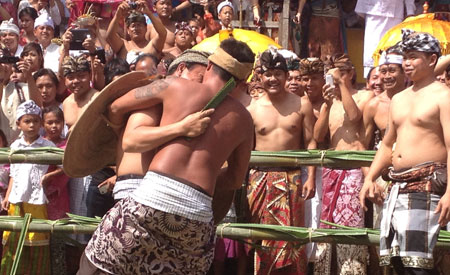Tari Rantak Kudo
Rantak is a dynamic and exciting dance to watch. This dance is usually performed at cultural, traditional events, including traditional Minangkabau wedding receptions. Characteristics of the Rantak Dance is inspired by the dynamic movements of the Pencak Silat. Pencak Silat is an Indonesian martial art influenced by the Minangkabau tradition. Aside from being beautiful to move, these movements also carry a deep philosophy of living, which includes:
1. Tagak-tagak (standing upright), a movement that symbolises the concept of contemplating before acting.
2. Ukua jo jangko (Move as if you were measuring something). This means to do everything according to one’s ability and to measure it correctly.
3. Pandang kutiko (to look), a movement signifying the ability to interpret events or teachings in a wise and non-judgmental way.
4. Garak-garik (moving), which is a movement that means initiative in doing something good, full of sensitivity and vigilance.
5. Raso pareso, a movement symbolising the union of the mind with the conscience.
This Rantak dance is characterised by firm movements. It is accompanied by foot stomps that make a sound, just like the movements of Pencak Silat. This dance often amazes the audience with its agility and fluidity.

Rampag Parebut Seeng
Rampag Parebut Seeng is a performance art that is a combination of dance and martial arts.
Rampag Parebut Seeng is a traditional art that has existed since the Sundanese Kasepuhan era. It is still performed at various traditional events of the Sundanese community, such as traditional weddings, circumcisions and Seren Taun.
In general, the rules of Rampag Parebut Seeng are very simple. One contestant carries a seeng, a traditional rice stove. Using martial arts movements, the other participants try to touch the rice stove. If the rice stove is successfully touched, the other participant must let the stove change hands. However, if the person grabbing the rice stove falls down, he/she is declared a failure and is replaced by another contestant. This continues until one person remains the winner. The winner in this performance is not defined by the victory over the others, but by the victory over the control of one’s own lust.
Rampag Parebut Seeng is more than a performance. It has a deep philosophical meaning about life. Seeng or stove is a symbol of wealth. A stove that is contested does not mean that one is fighting for wealth. Moreover, it is a form of self-restraint, because the greatest victory of a living being is the successful restraint of its desires.

Mekare-Kare
Mekare-Kare is usually held at the beginning of June each year in Tenganan village, Manggis district, Karangasem regency, Bali.
Mekare-Kare is performed in honour of Indra, the Hindu god of war. Through the performance of this ceremony, all men who take part in this dance will be considered to be strong and capable of war. They will fight with pandanus leaves, which have sharp thorns, and do whatever it takes to win the fight.
Mekare-kare is performed in rotation with other participants, usually for one-minute rounds.
Perang Pandan performers also carry a rattan shield for protection. Men who participate in Perang Pandan wear only a sarong (kamen), shawl (saput) and headband (udeng) and no clothes.
After the mekare-kare, almost all the participants will have wounds all over their bodies from the thorns of the pandanus leaves. Therefore, after the fighting, their bodies will be smeared with a traditional mixture of grated turmeric and galangal with the addition of coconut oil for treatment. As all participants do this sincerely as part of the traditional ceremony, there is no resentment or anger after the match.

